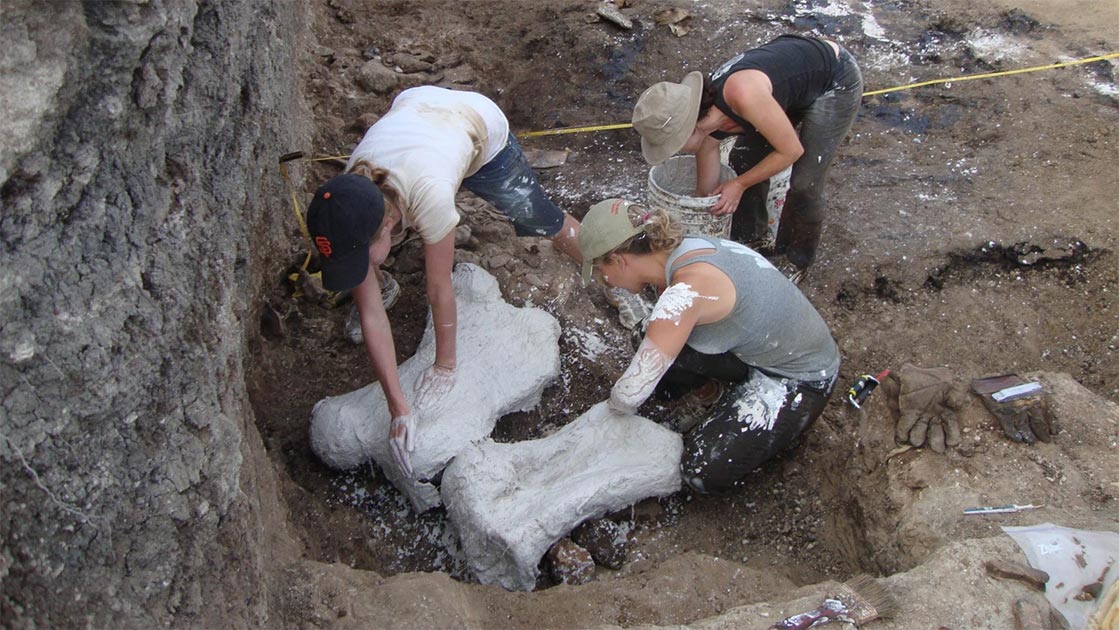Giant Sloth Death Pit Reveals Death By Feces Ingestion
The fossilized remains of 22 Ice Age, elephant sized sloths have been found preserved in 20,000-year-old asphalt in Ecuador. The discovery of this giant sloth death pit is revealing a virtual Bible of new evolutionary facts.
The ancient remains were found in Tanque Loma paleontological site, also known as Arroyo Seco, on the northern side of the Santa Elena Peninsula (SEP) in southwest Ecuador. 20,000 years ago this region was a dense marshland and the team of researchers found that the 22 giant sloths had died after “consuming their own feces”, before being preserved in the death pit by encroaching asphalt seeping up from the ground.
An Extended Family of Elephant-Sized Ancient Creatures
This famous dig site was first excavated in 2003 and because it is located on the side of a hill holding various oil tanks and containers, it has been named “'Tanque Loma,” or “Tank Hill.” The new study was led by University of California Los Angeles palaeontologist Emily Lindsey, who is also an assistant curator and excavation site director at the famous La Brea Tar Pits. The full findings of her study have been published in the journal Palaeogeography, Palaeoclimatology, Palaeoecology.
The team analyzed the remains of the 22 Ice Age sloths, which they said included: 15 adults, five juveniles, and two newborns or fetuses. But don’t for a second think these creatures were anything like the modern day sloth because not only could Eremotherium laurillardi walk fast on two legs, but an adult male was about the size of an elephant.

Fossils found in the giant sloth death pit. (La Brea Tar Pits)
The Giant Sloth Death Pit – A Self-Constructed Armageddon Thru Contamination
The cause of death would appear to the casual observer to have been that the giant sloths had become hopelessly trapped after falling into a tar pit, but Dr. Lindsey told Gizmodo the team of researchers believe they died from “drinking water contaminated by their own faeces.” Having suffered toxic poisoning, the 22 animals were subsequently coated in seeping asphalt. The archaeologists also discovered the fossilized remains of a “horse, a deer, an armadillo-like pampathere, and an elephant-like gomphothere.”
No significant aquatic fossils were found at the ancient marshland but the team discovered “an abundance of tiny, broken-up plant remains,” which they noted were smaller than the distance between the ridges of the ancient sloths' teeth; which means the plants probably came from the animals' feces, which might have contaminated the drinking water and subsequently killed them.
- Fossils of Giant Prehistoric Beasts Discovered in Underwater Ice Age Death Cave
- Radar Detects Invisible ‘Ghost Tracks’ of Humans and Mammoths
- First humans in Florida lived alongside giant animals

Rancho la Brea Tar Pool. Restoration by Charles. R. Knight for Amer. This image shows a giant sloth death pit with a sabre tooth cat and condors nearby. Source: Charles R. Knight / Public Domain
Sipping From the Poisoned Puddle of Doom
The grotesque nature of these 220 creatures’ deaths aside, this discovery is being called “science's gain,” as the giant sloth death pit assemblage has shined light on the animal's social nature, said palaeontologist José Luis Román-Carrión of the Escuela Politécnica Nacional university, to Gizmodo, and now scientists know ancient Eremotherium “lived in social groups, and had parental behaviour.”
While it might be the first time you have ever considered a group of giant life forms eating and dying in their own waste, it does occur from time to time in the worlds of paleontology and archaeology. An article in the The Daily Mail for example, tells of a team of scientists in the seventies discovering the remains of “140 hippos” that gathered around a watering hole in Tanzania's Selous Game Reserve. In this disaster, when the waterhole shrunk the excrement left by the mammals mounted in the little water that was left, and in what must have been a very grim moment in evolution, their self-created feces-riddled puddle eventually poisoned all of them.
- How to Hunt a Giant Sloth – Ancient Tactics Revealed in Human Footprints
- What Giant Beasts Carved Out these South American Mega-Tunnels?
- Evidence Mounts in Favor of Early Inhabitants of the Americas Over 20,000 Years Ago
Follow Me Down the Rabbit Hole
The scientists concluded that one of the “most intriguing aspects” of the new research lies not in the mystique of the giant sloths encrusted in their death pit of asphalt, but in the multiple layers of “microfauna-rich sediments” which form about a meter above the asphaltic megafauna deposit.
Down in these microscopic levels of analysis scientists can study the thousands of “small birds, lizards, snakes, and rodents bones” discovered at the site, which the scientist told Gizmodo holds real potential “to tell a story of past environmental change in this region.” And furthermore, once the microfauna-rich sediments are understood then this data can be interpreted against the greater rhizosphere, which Science Direct describes as any dynamic area or system governed by complex interactions between plants and the organisms associated with plant roots.
From the remains of the 22 gigantic creatures, who ate their own poop and died, all the way down here to the microcosmic rhizosphere, this prehistoric Ecuadorian death pit promises to educate, and to discriminate ancient knowledge about both the big bad world we populate, up here, and about the composition and complex patterns of ancient microbial activity.

Megatherium americanum, giant ground sloth. (Nobu Tamura/CC BY SA 4.0)
Top Image: Students make protective plaster wrappings for asphalt-preserved giant sloth bones at the Tanque Loma tar pit locality in southwestern Ecuador. (Martin Tomasz / La Brea Tar Pits)
By Ashley Cowie

















